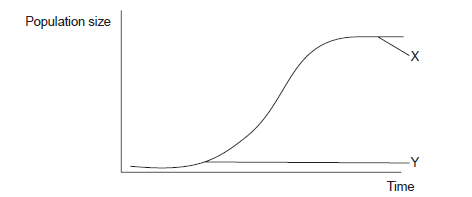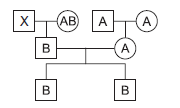Question
The diploid number of chromosomes in horses (Equus ferus) is 64 and the diploid number in donkeys (Equus africanus) is 62. When a male donkey and a female horse are mated, the result is a mule which has 63 chromosomes.
State the haploid number for horses.
Explain reasons that mules cannot reproduce.
Discuss whether or not horses and donkeys should be placed in the same species.
A mule was born at the University of Idaho in the USA with 64 chromosomes. Suggest a mechanism by which this could happen.
▶️Answer/Explanation
Markscheme
32
a. because the chromosome number is not an even number/63
b. (so) cannot divide by two during meiosis/cannot perform meiosis/chromosomes cannot pair up during meiosis
c. one chromosome has no homologue/WTTE
d. because unlikely to/cannot produce viable gametes/sperm/egg cells
a. to be in same species two organisms must have the same genes arranged on the same chromosomes
OR
must have the same number of chromosomes
b. members of same species produce fertile offspring and a mule is not fertile
non-disjunction
Accept description of non-disjunction.
Question
The graph shows a sigmoid population growth curve.

The table summarizes the genome size of several organisms.

The figure shows a pedigree chart for the blood groups of three generations.

Identify the phases labelled X and Y.
X:
Y:
Outline how fossil records can provide evidence for evolution.
Distinguish between the terms genotype and phenotype.
Outline a structural difference between the chromosomes of Helicobacter pylori and Homo sapiens.
Deduce the percentage of adenine in Oryza sativa if the proportion of guanine in that organism is 30 %.
Deduce the possible phenotypes of individual X.
Describe ABO blood groups as an example of codominance.
▶️Answer/Explanation
Markscheme
X: plateau phase
Y: exponential growth / log phase
(both needed)
a. the sequence in which fossils appear matches the expected sequence of evolution;
b. comparisons with fossils and living organisms (morphology) shows change in characteristics from an ancestral form / OWTTE;
Vestigial organs and homologous structures are acceptable answers.
c. fossils of extinct species show that (evolutionary) change has occurred;
d. fossils can be dated with radioisotopes / geological depth/strata indicates (relative) age/date of organism;
e. can yield DNA for molecular clock analysis;
f. example of any of the above can earn one mark (eg: reptiles follow amphibians);
genotype is the genetic make-up/set of alleles (of an organism) while phenotype is the characteristics (expressed/shown in an organism)
chromosome from bacteria has no protein associated/naked DNA / bacteria is circular, H. sapiens is linear / (chromosomes of) H. sapiens are much bigger/have many more base pairs than bacteria
N.B.: Answer must refer to “chromosomes” not genomes of the two organisms.
20 %
A, B, AB and O
All four phenotypes must be shown to award the mark.
allele IA and the allele IB are (co)dominant as they are both expressed in the heterozygote/AB type blood / OWTTE
Question
Describe the characteristics of stem cells that make them potentially useful in medicine.
Outline the inheritance of a named sex-linked condition in humans.
Explain the use of karyotyping in human genetics.
▶️Answer/Explanation
Markscheme
(stem cells) have/retain the capacity to divide;
can be used to produce cell cultures/large number of identical cells;
can be used to repair/replace damaged/lost cells/tissue;
(stem cells) are undifferentiated / have not yet differentiated/specialized;
can differentiate/specialize in different ways / are pluripotent/totipotent;
can be used to form a variety of different tissues / form organs;
used in medical research;
used in treatment of (named) disease;
genes that are located on just one of the sex chromosomes/X or Y are sex-linked;
(sex-linked) genes present on the X chromosome are absent from the Y chromosome / vice versa;
named recessive X-linked condition (e.g. colour blindness / haemophilia / other valid example);
sex-linked conditions tend to be more commonly expressed in males;
female can be homozygous or heterozygous/carrier for a sex-linked/X-linked condition;
affected males have only one copy of the gene / have carrier daughters but cannot pass the condition on to sons;
carrier/heterozygous females can have affected sons/carrier daughters;
for a female to be affected (homozygous recessive) the father must be affected;
If the example used is of a recessive X-linked condition, use marking points c–h.
Make appropriate adjustments if the example is of a dominant X-linked trait or a Y-linked trait.
Accept any of the above points shown in a suitable diagram/chart/Punnett square/pedigree.
Definition and construction of karyotypes:
karyotype is the number and type / image of chromosomes in a cell;
cells collected from chorionic villus / by amniocentesis;
requires cells in metaphase / stimulate cells to divide and reach metaphase;
burst cells and spread chromosomes / photo taken of chromosomes;
chromosomes are arranged in pairs;
according to size/structure/position of centromere/banding pattern;
Uses for karyotypes:
karyotypes used to identify sex/gender;
male is XY and female XX;
used to identify chromosome mutations/abnormal numbers/non-disjunction;
Down syndrome due to extra chromosome 21 / other trisomy/aneuploidy example;
used for pre-natal diagnosis of chromosome abnormalities;
may lead to a decision to abort the fetus;
prepare for consequences of abnormality in offspring;